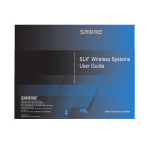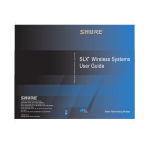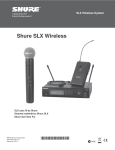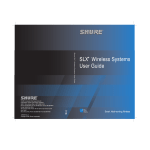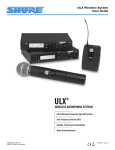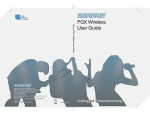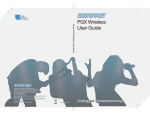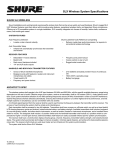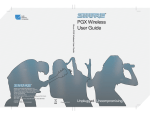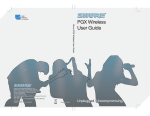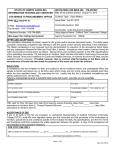Download Shure BLX2-K3E User guide
Transcript
Shure SLX Wireless
Shure SLX Wireless
Smart, Hard-working
Wireless
Congratulations! Welcome to Shure SLX Wireless. Your new system is rugged, reliable, easy
to set up and operate, and produces outstanding audio clarity. Whether you’re a vocalist, guitarist, or instrumentalist, your SLX Wireless system will show you how easy wireless can be, and
how good wireless can sound.
This user guide and the Quick Setup guide included with your system will tell you all you need
to know to get your system working right away.
Welcome to the world of SLX: smart, hard-working wireless.
Frequency Band Selection
Most countries closely regulate the radio frequencies used in the transmission of wireless information. These regulations state which devices can use which frequencies, and help to limit
the amount of RF (radio frequency) interference in all wireless communications.
To be flexible enough to operate worldwide, SLX receivers are available in a number of models, each with a unique frequency range. Each frequency range, or band, spans up to 24 MHz of
the wireless broadcast spectrum. Available bands are:
H5: 518–542 MHz
J3: 572–596 MHz
L4: 638–662 MHz
P4: 702–726 MHz
R13: 794-806 MHz
R5: 800–820 MHz
S6: 838–865 MHz
JB: 806–810 MHz
Q4: 740–752 MHz
To facilitate system setup and protect against RF interference, each system comes with multiple predefined frequency groups and channels.
When using a single SLX system, the operating frequency will generally not have to be
changed. In an installation with multiple receiver/transmitter systems, each system must operate
on a separate channel. The group and channel system provides an optimum frequency spread
when using multiple systems.
Within a single frequency band, up to 12 individual transmitter/receiver systems may be used
in a single installation. In regions where additional frequency bands are available, it is possible
to operate up to 20 systems simultaneously. Check with your local Shure retailer for information
on which bands are available in your area.
What Do You Want to Do
Now?
Learn about your SLX4 Receiver
Power, lock/unlock, front and back panel features: See “SLX4 Receiver Features” on page 5
and “SLX4 Receiver Programming” on page 9.
Learn about your SLX2 Handheld Transmitter
Power, mute, gain, lock/unlock, other features: See “SLX2 Handheld Transmitter” on page 6
and “SLX1 and SLX2 Transmitter Programming” on page 10.
Learn about your SLX1 Bodypack Transmitter
Power, mute, gain, lock/unlock, other features: See “SLX1 Bodypack Transmitter” on page 7
and “SLX1 and SLX2 Transmitter Programming” on page 10.
Program your SLX Receiver and Transmitter
Frequency selection, LCD features, using the select and menu buttons: See “SLX Programming” on page 9.
Learn how to use multiple systems in a single installation
See “Multiple System Setup” on page 8.
Troubleshoot your SLX system
See “Troubleshooting” on page 12.
2
English
Table of Contents
System Components . . . . . . . . . . . . . . . . . . . . . . . . . . . . . . . . . . . . . . . . . . . . . 4
SLX4 Receiver Features . . . . . . . . . . . . . . . . . . . . . . . . . . . . . . . . . . . . . . . . . . . 5
SLX2 Handheld Transmitter . . . . . . . . . . . . . . . . . . . . . . . . . . . . . . . . . . . . . . . . 6
SLX1 Bodypack Transmitter . . . . . . . . . . . . . . . . . . . . . . . . . . . . . . . . . . . . . . . 7
Single System Setup . . . . . . . . . . . . . . . . . . . . . . . . . . . . . . . . . . . . . . . . . . . . . 8
Multiple System Setup . . . . . . . . . . . . . . . . . . . . . . . . . . . . . . . . . . . . . . . . . . . . 8
SLX Programming. . . . . . . . . . . . . . . . . . . . . . . . . . . . . . . . . . . . . . . . . . . . . . . . 9
SLX4 Receiver Programming . . . . . . . . . . . . . . . . . . . . . . . . . . . . . . . . . . . . . . 9
SLX1 and SLX2 Transmitter Programming. . . . . . . . . . . . . . . . . . . . . . . . . . . 10
The Master Frequency List . . . . . . . . . . . . . . . . . . . . . . . . . . . . . . . . . . . . . . . 10
Rack-Mounting SLX Receivers . . . . . . . . . . . . . . . . . . . . . . . . . . . . . . . . . . . . 11
Receiver Volume Control . . . . . . . . . . . . . . . . . . . . . . . . . . . . . . . . . . . . . . . . . 12
Tips for Improving System Performance . . . . . . . . . . . . . . . . . . . . . . . . . . . . 12
Troubleshooting . . . . . . . . . . . . . . . . . . . . . . . . . . . . . . . . . . . . . . . . . . . . . . . . 12
Specifications . . . . . . . . . . . . . . . . . . . . . . . . . . . . . . . . . . . . . . . . . . . . . . . . . . 13
Replacement Parts and Accessories . . . . . . . . . . . . . . . . . . . . . . . . . . . . . . . 14
Microphone Specification . . . . . . . . . . . . . . . . . . . . . . . . . . . . . . . . . . . . . . . 132
Frequency Ranges . . . . . . . . . . . . . . . . . . . . . . . . . . . . . . . . . . . . . . . . . . . . . 135
Regulatory Statements . . . . . . . . . . . . . . . . . . . . . . . . . . . . . . . . . . . . . . . . . . 139
Patent numbers 6,597,301, 5,794,125, and 5,692,057.
3
Shure SLX Wireless
System Components
All systems include:
•
•
•
•
•
•
•
SLX4 receiver
Rack mount supplies
•
Short rack ear
•
Long rack ear
•
Link bar to mount to similar receiver
•
Extension cables and connectors for front-mounting antennas
•
8 rack ear screws
•
4 rack mount screws with washers
•
2 antenna hole plugs
Protective bumpers with 8 screws
2 AA batteries (4 in combo systems)
Power supply
2 1/4 Wave Antennas
User guide
+ - +
Vocalist system includes:
•
•
•
Microphone Head (choice of SM58®, SM86, Beta 58A®, Beta 87A™, or Beta 87C™)
SLX2 handheld transmitter Microphone clip SLX
mute
select
ss
le
e
ir e
id
® W
u
G
LX r
S se
U
S
ys
te
m
Lavalier, Headworn, and Instrument systems include:
s
•
•
SLX1 bodypack transmitter
Microphone (choice of WL93 , WL184 or WL185 , WH30 , or Beta 98H/C™ )
Guitar system includes:
•
•
SLX1 bodypack transmitter
1/4” to mini 4-pin guitar cable
4
English
SLX4 Receiver Features
Front Panel
SLX4
menu
sync
select
ready
audio
power
H5 518-542 Mhz
Audio LED
Infrared (IR) port
LCD panel
Sync Button
Indicates strength of incoming audio
signal.
Broadcasts IR signal to transmitter to
synchronize frequencies.
See “SLX Programming” on page 9.
Press to initiate IR connection between
receiver and transmitter. See “SLX
Programming” on page 9.
Menu switch
Press to scroll through menu options.
See “SLX Programming” on page 9.
On/Off switch
Tap to turn on, hold to turn off.
Select switch
Frequency Band
Press to select the currently displayed
menu option. See “SLX Programming”
on page 9.
Indicates the name and range of
receiver frequency band.
Sync Ready Indicator
Adding protective bumpers
Illuminates when frequencies of
receiver and transmitter are
synchronized. See “SLX Programming”
on page 9.
Recommended if receiver is not rack
mounted. Use supplied screws. For
rack-mounting instructions, See “RackMounting an SLX Receiver” on
page 11.
Back Panel
12–18 V
160 mA
SHURE INCORPORATED
NILES, IL 60714
SLX4 RECEIVER
UNBALANCED
HIGH Z
IC: 616A–SLX4
BALANCED
LOW Z
ANTENNA B
POWER
MIC OUT
LINE OUT
VOLUME
ANTENNA A
Antenna jack B
AC adapter jack
Adapter cord tie-off
1/4” output jack
Volume adjustment dial
Follow steps shown to secure cord to
receiver body
XLR output jack
5
Decreases receiver output level. See
“Receiver Volume Control” on page 12.
Antenna jack A
Shure SLX Wireless
SLX2 Handheld Transmitter
Features
Interchangeable microphone head (SM58 pictured)
Power / Infrared (IR) / Mute indicator
Green: ready
Amber: mute on
Flashing red: IR transmission in process
Glowing red: battery power low
Pulsing red: battery dead (transmitter cannot be turned on until batteries are changed)
LCD screen
See “SLX1 and SLX2 Transmitter Programming” on page 10.
On-off / mute switch
Press and hold to turn on or off. Press and release to mute or unmute.
SLX
To avoid accidentally muting the microphone during a performance, lock the front panel
while the microphone is in use. See “Lock or Unlock Transmitter Settings” on page 10.
mute
select
Select switch
See “SLX1 and SLX2 Transmitter Programming” on page 10.
IR port
Receives infrared beam to synchronize frequencies. When using multiple systems, only one
transmitter IR port should be exposed at a time.
SLX
mute
select
Changing Batteries
•
•
Expected life for an Alkaline battery is approximately 8 hours.
When the transmitter light glows red, the batteries should be changed immediately, as
shown on the left.
Adjusting Gain
•
•
Access the gain adjustment switch by unscrewing the head of the microphone.
Two gain settings are available on the SLX2. Choose a setting appropriate for vocal
volume and for the performing environment. Use the tip of a pen or a small screwdriver
to move the switch.
•
0dB: For quiet to normal vocal performance.
•
–10dB: For loud vocal performance.
BIAS
SLX
AUDIO
mute
select
-10dB
0dB
6
English
SLX1 Bodypack
Transmitter
Features
Antenna
Power / Infrared (IR) / Mute indicator
Green: ready
Amber: mute on
Flashing red: IR transmission in process
Glowing red: battery power low
Pulsing red: battery dead (transmitter cannot be turned off until batteries are changed)
LCD screen
See “SLX1 and SLX2 Transmitter Programming” on page 10.
Select switch
See “SLX1 and SLX2 Transmitter Programming” on page 10.
On-off / mute switch
Press and hold to turn on or off. Press and release to mute or unmute.
4-Pin Microphone Input Jack
IR port
Receives infrared beam to synchronize frequencies. When using multiple systems, only one
transmitter IR port should be exposed at a time.
Gain adjustment switch (see below)
Wearing the Bodypack Transmitter
•
•
Clip the transmitter to a belt or slide a guitar strap through the transmitter clip as
shown.
For best results, slide the transmitter until the belt is pressed against the base of the
clip.
Changing Batteries
•
•
Expected life for an Alkaline battery is approximately 8 hours.
When the transmitter light glows red, the batteries should be changed immediately, as
shown on the left.
Adjusting Gain
•
-10 0 mic
•
Three gain settings are available on the SLX1. Choose the appropriate setting for your
instrument.
•
mic: Microphone (higher amplification)
•
0: Guitar with passive pickups (medium amplification)
•
-10: Guitar with active pickups (lower amplification)
If the receiver LED indicates the input volume is overloading the receiver, try switching
the gain to a lower setting.
7
Shure SLX Wireless
Single System Setup
Note: transmitting devices such as cellular phones and two-way radios may interfere with
wireless audio transmissions. Keep your SLX transmitters and receivers away from these and
other potential sources of interference.
Follow these steps when using a single SLX system:
888.888
GROUP
1. Automatic Frequency Selection CHANNEL MASTER LIST
ANTENNA
MHz
GROUP MANUAL
AUTO
DISPLAY
EXIT
CHANNEL SELECT CHANNEL FREQUENCY MASTER
SELECT
SELECT
SELECT
LIST
A
B
menu
select
Scans for an available channel and sets the receiver to that channel.
LOW BATT
2. Automatic Transmitter Setup
sync
Turn On the transmitter.
.)
8 in
m(
5c
<1
Open the transmitter battery compartment to display the infrared (IR) port
(see page 6 and page 7).
or
With the IR port exposed to the receiver, press sync.
Hold the sync button until the red light stops flashing on both receiver and transmitter.
When the receiver ready light glows, the system is ready for use.
Close the transmitter battery compartment.
Multiple System Setup
Follow these steps when using multiple SLX systems in a single installation:
1.
2.
3.
4.
5.
Turn all receivers on and all transmitters off.
Set all receivers to the same frequency group (see “Group Selection” on page 9).
Perform Automatic Frequency Selection from the Single System Setup section
above.
Turn on the first transmitter.
Perform Automatic Transmitter Setup from the Single System Setup section above.
Repeat for each system.
Be sure that only one transmitter’s IR port is exposed when synchronizing a system.
8
English
SLX Programming
Any option displayed on screen will generally “time out” after five seconds.
SLX4 Receiver Programming
888.888
GROUP
Group Selection
CHANNEL MASTER LIST
ANTENNA
A
MHz
GROUP MANUAL
AUTO
DISPLAY
EXIT
CHANNEL SELECT CHANNEL FREQUENCY MASTER
SELECT
SELECT
SELECT
LIST
888.888
GROUP
LOW BATT
ANTENNA
A
MHz
888.888
LOW BATT
ANTENNA
A
MHz
888.888
ANTENNA
A
MHz
ANTENNA
A
MHz
B
A
MHz
GROUP MANUAL
AUTO
DISPLAY
EXIT
CHANNEL SELECT CHANNEL FREQUENCY MASTER
SELECT
SELECT
SELECT
LIST
sync
Allows manual selection of a frequency channel. Pressing select increases the channel number by one.When the correct frequency is displayed, either wait five seconds for the screen to
time out, or press sync.
4x
menu
select
Displays the current frequency in MHz for approximately 5 seconds. Press and hold to increase display length.
select
+
menu
Hold down the select key and press menu to lock or unlock the receiver. When locked, the
current receiver settings cannot be changed.
Indicates RF activity. Only one antenna is active at any one time.
B
Indicates a low transmitter battery charge.
LOW BATT
Full Group Warning
CHANNEL MASTER LIST
ANTENNA
GROUP MANUAL
AUTO
DISPLAY
EXIT
CHANNEL SELECT CHANNEL FREQUENCY MASTER
SELECT
SELECT
SELECT
LIST
Transmitter Battery Status
ANTENNA
MHz
select
LOW BATT
CHANNEL MASTER LIST
FULL
menu
Antenna Status
CHANNEL MASTER LIST
888.888
GROUP
B
LOW BATT
GROUP MANUAL
AUTO
DISPLAY
EXIT
CHANNEL SELECT CHANNEL FREQUENCY MASTER
SELECT
SELECT
SELECT
LIST
GROUP
3x
Lock or Unlock Receiver Settings
CHANNEL MASTER LIST
888.888
sync
LOW BATT
GROUP MANUAL
AUTO
DISPLAY
EXIT
CHANNEL SELECT CHANNEL FREQUENCY MASTER
SELECT
SELECT
SELECT
LIST
GROUP
B
select
Allows manual selection of a frequency group. Pressing select increases the group number
by one. When the correct frequency is displayed, either wait five seconds for the screen to time
out, or press sync. For best results when operating multiple systems, set all systems to a single
group; then set each system to a unique channel within that group.
For more information on frequency groups and channels, see “Frequency Band Selection” on
page 2.
Display Frequency
CHANNEL MASTER LIST
GROUP MANUAL
AUTO
DISPLAY
EXIT
CHANNEL SELECT CHANNEL FREQUENCY MASTER
SELECT
SELECT
SELECT
LIST
GROUP
B
menu
Manual Channel Selection
CHANNEL MASTER LIST
GROUP MANUAL
AUTO
DISPLAY
EXIT
CHANNEL SELECT CHANNEL FREQUENCY MASTER
SELECT
SELECT
SELECT
LIST
GROUP
B
2x
A
B
LOW BATT
The FULL warning indicates that all available channels in the currently selected group are in
use. When this occurs, reprogram all systems to an alternate group.
Press either the menu or select button to exit the warning screen.
9
Shure SLX Wireless
SLX1 and SLX2 Transmitter Programming
Incompatible
MASTER LIST
i8 i8
GROUP
CHANNEL
Manually Select a Group and/or Channel
Incompatible
MASTER LIST
i8 i8
GROUP
select
CHANNEL
1.
Press and hold the select button until the GROUP and CHANNEL displays begin to
alternate.
2.
To change the group setting, release the select button while GROUP is displayed .
While GROUP is flashing, pressing select increases the group setting by one.
To change the channel setting, release the select button while CHANNEL is displayed
. While CHANNEL is flashing, pressing select increases the channel setting by one.
select
3.
Lock or Unlock Transmitter Settings
Incompatible
i8 i8
CHANNEL
Incompatible
i8 i8
CHANNEL
Indicates charge remaining in transmitter batteries.
Master List Indicator
Incompatible
MASTER LIST
Indicates that a master list frequency is currently in use. No group or channel information is
displayed.
Note: the transmitter cannot be used to change master list settings.
i8 i8
GROUP
CHANNEL
INCOMPATIBLE Frequency Warning
Incompatible
MASTER LIST
The INCOMPATIBLE warning indicates that the receiver and transmitter are set to incompatible frequency bands. Contact your Shure retailer for assistance.
i8 i8
GROUP
+
Battery Status
MASTER LIST
GROUP
select
Press the mute/ and select buttons simultaneously to lock or unlock the transmitter settings. When locked, the current settings cannot be changed manually. Locking the transmitter
does not disable infrared synchronization.
MASTER LIST
GROUP
5
select
CHANNEL
The Master Frequency List
888.888
GROUP
Using the Master List
CHANNEL MASTER LIST
ANTENNA
MHz
A
GROUP MANUAL
AUTO
DISPLAY
EXIT
CHANNEL SELECT CHANNEL FREQUENCY MASTER
SELECT
SELECT
SELECT
LIST
B
LOW BATT
menu
+
The “Master List” of frequencies should be accessed only by experienced users in situations
which call for precise frequency selection. The “Master List” is a comprehensive index of all available frequencies in 25 kHz increments. (125 kHz increments in the JB band.)
To access the Master List, hold down the menu button while powering on the SLX receiver.
Select Frequencies in the Master List 888.888
GROUP
ANTENNA
MHz
888.888
A
B
LOW BATT
select
sync
A
menu
select
To exit the Master List and return to normal system operations, press menu, then select.
ANTENNA
MHz
select
While FREQUENCY SELECT is flashing, the select button scrolls down through all available
frequencies; the menu button scrolls up. Press and release to change the frequency in 25 kHz
increments; press and hold to scroll quickly.
When the correct frequency is displayed, either wait five seconds for the screen to time out,
or press sync.
Exit the Master List 2x
CHANNEL MASTER LIST
GROUP MANUAL
AUTO
DISPLAY
EXIT
CHANNEL SELECT CHANNEL FREQUENCY MASTER
SELECT
SELECT
SELECT
LIST
menu
CHANNEL MASTER LIST
GROUP MANUAL
AUTO
DISPLAY
EXIT
CHANNEL SELECT CHANNEL FREQUENCY MASTER
SELECT
SELECT
SELECT
LIST
GROUP
menu
B
LOW BATT
10
English
Rack-Mounting an SLX
Receiver
The supplied mounting hardware allows an SLX receiver to be mounted in any standard 19”
audio equipment rack.
Hardware (Included)
Assembly
Tools (Not Included)
Rack-Mounting SLX Receivers
One Receiver
Wiring
Required Accessories
12–18 V
170 mA
SHURE INCORPORATED
NILES, IL 60714
SLX4 RECEIVER
UNBALANCED
HIGH Z
BALANCED
LOW Z
N108
IC: 616A–SLX4
ANTENNA B
SLX4
POWER
MIC OUT
LINE OUT
VOLUME
• All accessories
supplied
ANTENNA A
Two Receivers
• 1 x UA440
12–18 V
170 mA
12–18 V
170 mA
SHURE INCORPORATED
NILES, IL 60714
SLX4 RECEIVER
UNBALANCED
HIGH Z
BALANCED
LOW Z
SHURE INCORPORATED
NILES, IL 60714
SLX4 RECEIVER
UNBALANCED
HIGH Z
BALANCED
LOW Z
N108
N108
IC: 616A–SLX4
ANTENNA B
SLX4
POWER
MIC OUT
LINE OUT
IC: 616A–SLX4
VOLUME
ANTENNA A
ANTENNA B
POWER
MIC OUT
LINE OUT
VOLUME
ANTENNA A
SLX4
Two Receivers with UA221 Antenna Splitter/Combiner Kit
12–18 V
170 mA
12–18 V
170 mA
SHURE INCORPORATED
NILES, IL 60714
SLX4 RECEIVER
UNBALANCED
HIGH Z
BALANCED
LOW Z
SHURE INCORPORATED
NILES, IL 60714
SLX4 RECEIVER
UNBALANCED
HIGH Z
BALANCED
LOW Z
N108
SLX4
POWER
MIC OUT
LINE OUT
• 1 x UA221
N108
IC: 616A–SLX4
ANTENNA B
IC: 616A–SLX4
VOLUME
ANTENNA A
ANTENNA B
POWER
MIC OUT
LINE OUT
VOLUME
ANTENNA A
SLX4
Three or Four Receivers
• 1 x UA844
UHF ANTENNA / POWER DISTRIBUTION SYSTEM
UA844
POWER
12–18 V
170 mA
SLX4
SLX4
12–18 V
170 mA
SHURE INCORPORATED
NILES, IL 60714
SLX4 RECEIVER
UNBALANCED
HIGH Z
BALANCED
LOW Z
SHURE INCORPORATED
NILES, IL 60714
SLX4 RECEIVER
UNBALANCED
HIGH Z
BALANCED
LOW Z
N108
N108
IC: 616A–SLX4
ANTENNA B
POWER
MIC OUT
12–18 V
170 mA
SLX4
LINE OUT
ANTENNA A
SHURE INCORPORATED
NILES, IL 60714
SLX4 RECEIVER
UNBALANCED
HIGH Z
BALANCED
LOW Z
IC: 616A–SLX4
VOLUME
N108
IC: 616A–SLX4
ANTENNA B
POWER
11
MIC OUT
LINE OUT
VOLUME
ANTENNA A
ANTENNA B
POWER
MIC OUT
LINE OUT
VOLUME
ANTENNA A
Shure SLX Wireless
Receiver Volume
Control
The volume control dial should generally be left in the clockwise position. Turning the dial counter-clockwise
decreases receiver output level.
If adjustments are necessary, use a small screwdriver to turn the dial.
Tips for Improving System Performance
•
•
•
•
Maintain a line of sight between transmitter and antenna
Avoid placing the receiver near metal surfaces or any digital equipment (CD players, computers, etc.)
Secure the AC adapter cable to the receiver using the cable retainer loop
If rack-mounting the receiver, front-mount the antennas as shown on page 11.
Troubleshooting
Issue
Indicator Status
Solution
No sound or faint
sound
Transmitter power light off
•
•
•
Turn transmitter on (see pages 6 and 7)
Make sure the +/- indicators on battery match the transmitter terminals
Insert a fresh battery
Receiver LCD off
•
•
Make sure AC adapter is securely plugged into electrical outlet and into
DC input connector on rear panel of receiver
Make sure AC electrical outlet works and is supplying proper voltage
Receiver display indicates antenna
activity
•
•
•
•
Press mute switch on transmitter (see pages 6 and 7)
Turn up receiver volume control (see page 5)
Increase transmitter gain switch setting (see pages 6 and 7)
Check cable connection between receiver and amplifier or mixer
Receiver display indicates no
antenna activity; transmitter and
receiver power lights glowing
•
•
•
•
•
Extend receiver antennas vertically
Move receiver away from metal objects
Check for line of sight between transmitter and receiver
Move transmitter closer to receiver
Check that receiver and transmitter are using the same frequency
Transmitter power light glowing or
flashing red
•
Replace transmitter batteries
INCOMPATIBLE warning on
transmitter
•
The INCOMPATIBLE warning indicates that the receiver and transmitter
are set to incompatible frequency bands. Contact your Shure retailer for
assistance.
Distortion or
unwanted noise
bursts
Receiver display indicates antenna
activity
•
Remove nearby sources of RF interference (CD players, computers,
digital effects, in-ear monitor systems, etc.)
Change receiver and transmitter to a different frequency (see page 9)
Reduce transmitter gain (see pages 6 and 7)
Replace transmitter battery
If using multiple systems, increase the frequency spread between
systems (see page 9).
Distortion level
increases gradually
Transmitter power light glowing or
flashing red
•
•
•
•
•
Replace transmitter batteries
Sound level different
from cabled guitar or
microphone, or when
using different guitars
•
Adjust transmitter gain (see pages 6 and 7) and receiver volume (see
page 5) as necessary
FULL warning
displays on receiver
•
The FULL warning indicates that all available channels in the currently
selected group are in use. When this occurs, reprogram all systems to an
alternate group.
•
Replace transmitter batteries
Cannot turn
transmitter off
Transmitter light flashing red
12
English
Specifications
System
Frequency Range and Transmitter Output Level
Band
H5
J3
L4
P4
R13
R5
S6
JB
Q4
Range
Transmitter output
518–542 MHz
30 mW
572–596 MHz
30 mW
638–662 MHz
30 mW
702–726 MHz
30 mW
20 mW
838–865 MHz
10 mW
806–810 MHz
10 mW
740–752 MHz
10 mW
Housing
Molded ABS case
Power Requirements
2 “AA” size alkaline or rechargeable batteries
Battery Life
>8 hours (alkaline)
794-806 MHz 20 mW
800–820 MHz
Weight
81 grams (3 oz.) without batteries
SLX2 Handheld Transmitter
Audio Input Level
+2 dBV maximum at -10dB position
-8 dBV maximum at 0dB position
NOTE: This Radio apparatus may be capable of
operating on some frequencies not authorized in your
region. Please contact your national authority to obtain
information on authorized frequencies for wireless
microphone products in your region.
Operating Range Under Typical Conditions
100m (300 ft.)
Note: actual range depends on RF signal absorption,
reflection, and interference
Audio Frequency Response (+/– 2 dB)
Minimum: 45 Hz
Maximum: 15 kHz
(Overall system frequency depends on
microphone element.)
Total Harmonic Distortion (ref. +/– 38 kHz deviation,
1 kHz tone)
0.5%, typical
Dynamic Range
>100 dB A-weighted
Gain Adjustment Range
10dB
RF Transmitter Output
30 mW maximum (dependent on applicable country
regulations)
Dimensions (including SM58 cartridge)
254 mm x 51 mm dia. (10 x 2 in.)
Weight
290 grams (10.2 oz.) without batteries
Housing
Molded PC/ABS handle and battery cup
Power Requirements
2 “AA” size alkaline or rechargeable batteries
Battery Life
>8 hours (alkaline)
SLX4 Receiver
Dimensions
42 mm H x 197 mm W x 134 mm D (1.65 x 7.76 x
5.28 in.)
Operating Temperature Range
–18°C (0°F) to +57°C (+135°F)
Note: battery characteristics may limit this range
Transmitter Audio Polarity
Positive pressure on microphone diaphragm (or positive
voltage applied to tip of WA302 phone plug) produces
positive voltage on pin 2 (with respect to pin 3 of low
impedance output) and the tip of the high impedance
1/4-inch output.
SLX1 Bodypack Transmitter
Audio Input Level
-10 dBV maximum at mic gain position
+10 dBV maximum at 0 dB gain position
+20 dBV maximum at -10 dB gain position
Gain Adjustment Range
30dB
Input Impedance
1 MΩ
RF Transmitter Output
30 mW maximum (dependent on applicable country
regulations)
Dimensions
108 mm H x 64 mm W x 19 mm D (4.25 x 2.50 x
0.75 in.)
13
Weight
816 g (1 lb. 13 oz.)
Housing
Galvanized steel
Audio Output Level (ref. +/– 38 kHz deviation with 1 kHz
tone)
XLR connector (into 600 Ω load): –13 dBV
1/4 inch connector (into 3000 Ω load): –2 dBV
Output Impedance
XLR connector: 200 Ω
1/4 inch connector: 1kΩ
XLR output
Impedance balanced
Pin 1: Ground (cable shield)
Pin 2: Audio
Pin 3: No Audio
Sensitivity
–105 dBm for 12 dB SINAD, typical
Image Rejection
>70 dB, typical
Power Requirements
12–18 Vdc at 150 mA, supplied by external power
supply
Shure SLX Wireless
Replacement
Parts and
Accessories
Replacement Parts (all systems)
Optional Accessories
Microphone Stand Adapter (SLX2)
WA371
Carrying Case
WA610
Zipper Bag (SLX1)
26A13
Black Grille (SLX2/BETA 58)
RK323G
Zipper Bag (SLX2)
26A14
Black Grille (SLX2/BETA 87A)
RK324G
Short Rack Bar
53A8611
Long Rack Bar
53A8612
Antenna Combiners and Accessories
Link Bar
53B8443
Antennas and receivers must be from the same
band.
The supplied 1/4 wave antennas can be used when
mounted directly to the UA844. If antennas are remote
mounted, 1/2 wave antennas must be used.
Antennas and cables are for use with UA844, and
cannot be used with stand-alone SLX receivers.
Antenna extension cables (2)
95A9023
Protective Bumpers (SLX4 Receiver) (4)
90A8977
Replacement Parts (system-specific)
AC Adapter (120 VAC, 60 Hz)
PS20
AC Adapter (220 VAC, 50 Hz)
PS20AR
AC Adapter (230 VAC, 50/60 Hz, Europlug)
PS20E
AC Adapter (230 VAC, 50/60 Hz, UK)
PS20UK
AC Adapter (100 VAC, 50/60 Hz)
PS20J
SM58 Head with Grille (SLX2/SM58)
RPW112
SM86 Head with Grille (SLX2/SM86)
RPW114
BETA 58 Head with Grille (SLX2/BETA 58)
RPW118
BETA 87A Head with Grille
(SLX2/BETA 87A)
RPW120
Passive Antenna/Splitter Combiner Kit
(recommended for 2 receivers)
UA221
UHF Antenna Power Distribution Amplifier
(recommended for 3 or more receivers)
U.S.A.
Europe
UK
1/2 Wave Antenna Remote Mount Kit
UA844US
UA844E
UA844UK
UA500
1/2 wave antenna
H5 Band
UA820H
J3 Band
UA820F
L4 Band
UA820L
Beta 87C™ Head with Grille
(SLX2/Beta 87C™)
RPW122
Matte Silver Grille (SLX2/SM58)
RK143G
P4, Q4 Bands
UA820B
Matte Silver Grille (SLX2/SM86)
RPM266
R13, R5, S6, JB Bands
UA820A
Matte Silver Grille (SLX2/BETA 58)
RK265G
25’ Antenna Cable
UA825
Matte Silver Grille (SLX2/BETA 87A)
RK312
50’ Antenna Cable
UA850
Matte Silver Grille (SLX2/Beta 87C™)
RK312
100’Antenna Cable
UA100
Belt Clip
44A8030
1/4-Wave Antenna (518–752 MHz)
UA400B
1/4-Wave Antenna (748–865 MHz)
UA400
14
Shure SLX Wireless
Microphone Specifications
WL183
+20
180°
150°
150°
+10
120°
dB
120°
0
90°
90°
–10
–20 dB
–15 dB
60°
-20
2
20
50 100
3 4 5 6 7 89
1000
2
60°
–10 dB
3 4 5 6 7 89
10000 20000
–5 dB
30°
30°
Hz
0
WL184
+20
180°
150°
150°
+10
120°
dB
120°
0
90°
90°
–20 dB
–10
–15 dB
60°
-20
2
20
50 100
3 4 5 6 7 89
1000
2
60°
–10 dB
3 4 5 6 7 89
10000 20000
–5 dB
30°
30°
Hz
0
WL185
+20
180°
150°
dB
+10
150°
120°
120°
0
90°
90°
–20 dB
–10
–15 dB
60°
-20
2
20
3 4 5 6 7 89
1000
50 100
2
60°
–10 dB
3 4 5 6 7 89
10000 20000
–5 dB
30°
30°
0
Hz
WL50
180°
+20
150°
Mid Boost
Equalization Cap
High Boost
Equalization Cap
dB
+10
150°
120°
120°
0
90°
90°
–20 dB
–10
–15 dB
60°
-20
20
2
50 100
3 4 5 6 7 89
1000
2
60°
–10 dB
–5 dB
3 4 5 6 7 89
10000 20000
30°
30°
0
Hz
WL51
180°
+20
+10
dB
180°
150°
120°
120°
On Axis
0
180° Off Axis
–10
150°
150°
90°
90°
60°
120°
120°
90°
90°
–20 dB
–20 dB
–15 dB
–15 dB
60°
–10 dB
60°
20
2
50 100
3 4 5 6 7 89
1000
Hz
132
2
3 4 5 6 7 89
10000 20000
60°
–10 dB
–5 dB
-20
150°
–5 dB
30°
30°
0
30°
30°
0
250 Hz
2500 Hz
500 Hz
6300 Hz
1000 Hz
10000 Hz
Microphone Specifications
Microphone Specifications
WH20
180°
+20
150°
120°
120°
+10
dB
150°
0
90°
90°
–20 dB
–15 dB
–10
60°
60°
–10 dB
–5 dB
-20
20
2
50 100
3 4 5 6 7 89
1000
2
30°
30°
3 4 5 6 7 89
10000 20000
0
500 Hz
Hz
1000 Hz
4000 Hz
WH30
180°
+20
180°
150°
dB
120°
120°
+10
0
150°
150°
1 cm (.4 in)
606 mm (2 ft)
90°
90°
120°
120°
90°
90°
–20 dB
–20 dB
–15 dB
–10
60°
–15 dB
60°
–10 dB
60°
20
2
50 100
3 4 5 6 7 89
1000
2
–5 dB
30°
30°
3 4 5 6 7 89
10000 20000
30°
30°
0
0
125 Hz
Hz
60°
–10 dB
–5 dB
-20
150°
1000 Hz
250 Hz
5000 Hz
500 Hz
10000 Hz
BETA98H/C
180°
+20
+10
dB
180°
150°
1 cm (3/8 in)
60.6 cm (2 ft)
120°
120°
0
90°
90°
–10
150°
150°
60°
120°
120°
90°
90°
–20 dB
–20 dB
–15 dB
–15 dB
60°
–10 dB
60°
20
2
50 100
3 4 5 6 7 89
1000
2
–5 dB
30°
30°
3 4 5 6 7 89
10000 20000
30°
30°
0
0
125 Hz
Hz
60°
–10 dB
–5 dB
-20
150°
1000 Hz
250 Hz
5000 Hz
500 Hz
10000 Hz
SM58
180°
+20
0
150°
150°
120°
120°
+10
dB
180°
150°
90°
90°
–10
60°
120°
90°
90°
–20 dB
–20 dB
–15 dB
–15 dB
60°
–10 dB
60°
20
2
50 100
3 4 5 6 7 89
1000
2
–5 dB
30°
30°
3 4 5 6 7 89
10000 20000
30°
30°
0
0
125 Hz
Hz
60°
–10 dB
–5 dB
-20
150°
120°
2000 Hz
500 Hz
4000 Hz
1000 Hz
8000 Hz
SM86
180°
+20
dB
+10
150°
150°
120°
120°
0
90°
90°
–10
60°
2
50 100
3 4 5 6 7 89
1000
Hz
133
2
3 4 5 6 7 89
10000 20000
150°
120°
120°
90°
90°
–20 dB
–20 dB
–15 dB
–15 dB
60°
–10 dB
60°
60°
–10 dB
–5 dB
-20
20
180°
150°
–5 dB
30°
30°
0
30°
30°
0
250 Hz
2500 Hz
500 Hz
6400 Hz
1000 Hz
10000 Hz
Shure SLX Wireless
Microphone Specifications
BETA58
180°
+20
dB
+10
180°
150°
3 mm (1/8 in)
25 mm (1 in)
51 mm (2 in)
606 mm (2 ft)
120°
120°
0
150°
150°
90°
90°
120°
120°
90°
90°
–20 dB
–20 dB
–15 dB
–10
60°
–15 dB
60°
–10 dB
60°
20
2
50 100
3 4 5 6 7 89
1000
2
–5 dB
30°
30°
3 4 5 6 7 89
10000 20000
30°
30°
0
0
250 Hz
Hz
60°
–10 dB
–5 dB
-20
150°
2500 Hz
500 Hz
6300 Hz
1000 Hz
10000 Hz
BETA87A
180°
+20
+10
dB
180°
150°
1 cm (3/8 in)
60.6 cm (2 ft)
120°
120°
0
150°
150°
90°
90°
120°
120°
90°
90°
–20 dB
–20 dB
–15 dB
–10
60°
–15 dB
60°
–10 dB
60°
20
2
50 100
3 4 5 6 7 89
1000
2
–5 dB
30°
30°
3 4 5 6 7 89
10000 20000
30°
30°
0
0
250 Hz
Hz
60°
–10 dB
–5 dB
-20
150°
2500 Hz
500 Hz
6300 Hz
1000 Hz
10000 Hz
BETA87C
180°
+20
+10
dB
180°
150°
1 cm (3/8 in)
60.6 cm (2 ft)
0
120°
120°
90°
90°
–10
150°
150°
60°
120°
120°
90°
90°
–20 dB
–20 dB
–15 dB
–15 dB
60°
–10 dB
60°
20
2
50 100
3 4 5 6 7 89
1000
Hz
134
2
3 4 5 6 7 89
10000 20000
60°
–10 dB
–5 dB
-20
150°
–5 dB
30°
30°
0
30°
30°
0
250 Hz
2500 Hz
500 Hz
5000 Hz
1000 Hz
10000 Hz
English
Frequency
Ranges
H5: 518.000–542.000 MHz
1
2
3
4
5
6
7
8
9
10
11
12
Group 1
Group 2
Group 3
Group 4
Group 5
Group 6
518.400
521.500
523.575
525.050
527.425
529.200
532.450
533.650
535.275
537.775
539.500
540.750
519.250
520.500
522.225
524.725
526.350
527.550
530.800
532.575
534.950
536.425
538.500
541.600
518.200
519.675
520.800
522.450
523.750
526.200
528.325
532.225
534.525
536.575
539.600
541.575
519.775
522.500
524.200
525.600
526.700
528.250
529.500
533.100
535.425
537.450
538.775
540.900
519.100
521.225
522.550
524.575
526.900
530.500
531.750
533.300
534.400
535.800
537.500
540.225
518.425
520.400
523.425
525.475
527.775
531.675
533.800
536.250
537.550
539.200
540.325
541.800
Full Range even distribution for
each TV-CH
Full Range even distribution for
each TV-CH
Full Range - max.
# of frequencies
for CH- 22
Full Range - max.
# of frequencies
for CH- 23
Full Range - max.
# of frequencies
for CH- 24
Full Range - max.
# of frequencies
for CH- 25
J3: 572.000–596.000 MHz
1
2
3
4
5
6
7
8
9
10
11
12
Group 1
Group 2
Group 3
Group 4
Group 5
Group 6
572.400
575.500
577.575
579.050
581.425
583.200
586.450
587.650
589.275
591.775
593.500
594.750
573.250
574.500
576.225
578.725
580.350
581.550
584.800
586.575
588.950
590.425
592.500
595.600
572.200
573.675
574.800
576.450
577.750
580.200
582.325
586.225
588.525
590.575
593.600
595.575
573.775
576.500
578.200
579.600
580.700
582.250
583.500
587.100
589.425
591.450
592.775
594.900
573.100
575.225
576.550
578.575
580.900
584.500
585.750
587.300
588.400
589.800
591.500
594.225
572.425
574.400
577.425
579.475
581.775
585.675
587.800
590.250
591.550
593.200
594.325
595.800
Full Range even distribution for
each TV-CH
Full Range even distribution for
each TV-CH
Full Range - max.
# of frequencies
for CH- 31
Full Range - max.
# of frequencies
for CH- 32
Full Range - max.
# of frequencies
for CH- 33
Full Range - max.
# of frequencies
for CH- 34
L4: 638.000–662.000 MHz
1
2
3
4
5
6
7
8
9
10
11
12
Group 1
Group 2
Group 3
Group 4
Group 5
Group 6
638.400
641.500
643.575
645.050
647.425
649.200
652.450
653.650
655.275
657.775
659.500
660.750
639.250
640.500
642.225
644.725
646.350
647.550
650.800
652.575
654.950
656.425
658.500
661.600
638.200
639.675
640.800
642.450
643.750
646.200
648.325
652.225
654.525
656.575
659.600
661.575
639.775
642.500
644.200
645.600
646.700
648.250
649.500
653.100
655.425
657.450
658.775
660.900
639.100
641.225
642.550
644.575
646.900
650.500
651.750
653.300
654.400
655.800
657.500
660.225
638.425
640.400
643.425
645.475
647.775
651.675
653.800
656.250
657.550
659.200
660.325
661.800
Full Range even distribution for
each TV-CH
Full Range even distribution
for each TV-CH
Full Range - max.
# of frequencies
for CH- 42
Full Range - max.
# of frequencies
for CH- 43
Full Range - max.
# of frequencies
for CH- 44
Full Range - max.
# of frequencies
for CH- 45
135
Shure SLX Wireless
Frequency
Ranges
P4: 702.000–726.000 MHz
1
2
3
4
5
6
7
8
9
10
11
12
1
2
3
4
5
6
7
8
9
10
11
Frequency
Ranges
Group 1
Group 2
Group 3
Group 4
Group 5
Group 6
Group 7
Group 8
702.200
704.200
707.200
709.425
711.000
713.675
715.575
717.050
719.150
720.800
722.025
724.250
703.750
705.975
707.200
708.850
710.950
712.425
714.325
717.000
718.575
720.800
723.800
725.800
703.650
705.650
708.650
710.875
712.450
715.125
717.025
718.500
720.600
722.250
723.475
725.700
702.750
704.500
705.750
708.250
711.250
712.500
715.250
718.750
721.250
723.250
703.750
705.750
708.250
711.750
714.500
715.750
718.750
721.250
722.500
724.250
702.100
704.025
705.500
708.500
710.100
712.025
713.500
717.300
725.300
704.775
706.225
710.500
712.025
714.225
716.900
718.500
720.775
725.300
702.300
704.975
706.775
709.100
710.300
712.225
714.775
716.700
724.000
725.900
Full Range max. # of
compatible
frequencies
Full Range max. # of
compatible
frequencies
Full Range max. # of
compatible
frequencies
France
preferred:
User Group A
France
preferred:
User Group A
France
preferred:
User Group B
France
preferred:
User Group B
France
preferred:
User Group C)
Group 9
Group 10
Group 11
Group 12
Group 13
Group 14
Group 15
Group 16
703.000
706.025
708.000
710.300
712.225
716.000
717.100
719.000
720.225
722.775
724.700
702.200
703.300
704.700
705.800
707.675
708.775
710.200
711.300
712.700
713.800
715.675
716.775
718.200
719.300
720.700
721.800
723.675
702.550
705.600
707.500
709.000
711.500
715.100
717.000
720.000
723.500
725.900
702.100
704.700
710.300
712.400
714.000
716.500
719.400
721.300
702.700
704.700
709.450
711.500
714.500
716.550
719.900
722.000
724.700
725.900
702.500
705.500
707.000
712.200
714.100
716.400
719.500
722.200
France
preferred:
User Group C
Optimized TV
channels: TV
ch. 50 702710 MHz
Optimized TV
channels: TV
ch. 51 710718 MHz
Optimized TV
channels: TV
ch. 52 718724 MHz
Compatible
setup for use
with
PSM400-P3
(P4 > P3)
Compatible
setup for use
with
PSM400-P3
(P4 = P3)
Compatible
setup for use
with
PSM400-HF
(P4 > HF)
Compatible
setup for use
with
PSM400-HF
(P4 = HF)
R5: 800.100–819.900 MHz
1
2
3
4
5
6
7
8
9
10
11
1
2
3
4
5
6
7
8
Group 1
Group2
Group 3
Group 4
Group 5
Group 6
Group 7
801.250
804.825
806.975
808.800
810.325
811.550
813.175
815.275
816.650
818.650
819.750
801.225
804.800
806.950
808.775
810.300
811.525
813.150
815.250
816.625
818.625
819.800
800.950
802.950
804.325
806.425
808.050
809.275
810.800
812.625
814.775
818.350
819.775
800.525
801.925
803.650
804.850
807.400
808.525
810.275
811.550
813.775
801.475
803.025
805.800
806.950
809.125
810.575
811.725
813.800
800.600
802.050
804.275
805.750
806.850
808.550
809.875
812.350
813.450
800.650
803.125
804.450
806.150
807.250
808.725
810.950
812.400
813.500
Full Range max. # of comp.
Frequencies &
FIN / NOR /
DEN
Full Range max. # of comp.
Frequencies &
FIN / NOR /
DEN
Full Range max. # of comp.
Frequencies &
FIN / NOR /
DEN
Germany
preferred: User
Group 4 800814 MHz
Germany
preferred: User
Group 4 800814 MHz
Sweden
preferred:
800-814 MHz
Sweden
preferred:
800-814 MHz
Group 8
Group 9
Group 10
Group 11
Group 12
Group 13
Group 14
806.000
807.100
808.500
809.600
811.475
812.575
813.975
806.025
807.425
808.525
810.400
811.500
812.900
814.000
801.400
808.300
816.400
800.900
802.100
806.200
809.300
814.100
816.100
817.200
819.600
801.200
803.800
805.900
807.000
809.200
811.700
803.850
807.000
809.700
811.050
813.900
816.500
817.600
819.500
806.150
811.650
814.400
816.500
817.450
819.300
Netherlands
preferred:
TV
ch. 63
806814 MHz
Netherlands
preferred:
TV
ch. 63
806814 MHz
Compatible
setup for use
with
EUT-TL-TV
(R5 > TL-TV)
Compatible
setup for use
with
PSM400MN (R5 > MN)
Compatible
setup for use
with
PSM400MN (R5 = MN)
Compatible
setup for use
with
PSM200R8 (R5 > R8)
Compatible
setup for use
with
PSM200R8 (R5 = R8)
136
English
Frequency
Ranges
S6: 838.000–865.000 MHz
1
2
3
4
5
6
7
8
9
10
11
12
13
1
2
3
4
5
6
7
8
9
10
11
12
13
Group 1
Group 2
Group 3
Group 4
Group 5
Group 6
Group 7
Group 8
838.200
841.450
843.275
846.225
847.350
850.125
852.575
854.575
856.200
860.125
861.300
863.225
864.450
838.150
839.375
841.300
842.475
846.400
848.025
850.025
852.475
855.250
856.375
859.325
861.150
864.400
838.550
839.775
841.700
842.875
846.800
848.425
850.425
852.875
855.650
856.775
859.725
861.550
864.800
854.200
855.300
856.700
857.800
859.675
860.775
855.475
857.425
860.600
855.075
857.775
860.725
854.750
855.850
857.250
858.350
860.225
861.325
854.750
855.850
857.250
858.350
860.225
861.325
Full Range max. # of
compatible
frequencies
Full Range max. # of
compatible
frequencies
Full Rangemax. # of
compatible
frequencies
BEL / TUR
preferred:
opt. TV ch.69
854-862 MHz
U.K.
preferred:
"CH69 Coordinated"
SET 1
U.K.
preferred:
"CH69 Coordinated"
SET 2 or SET
3
U.K. preferred:
"Co-ordinated
frequencies"
INDOORS
U.K. preferred:
"Co-ordinated
frequencies"
OUTDOORS
Group 9
Group 10
Group 11
Group 12
Group 13
Group 14
Group 15
854.425
855.525
857.400
858.500
859.900
861.000
863.200
864.500
838.200
839.900
841.000
842.375
844.400
846.100
847.350
849.400
851.800
853.200
838.900
842.600
845.900
847.500
848.600
850.100
852.100
853.300
855.100
857.200
858.650
859.800
861.900
838.100
841.100
842.700
847.000
849.200
850.400
852.500
854.100
855.300
838.700
842.800
844.800
846.300
847.400
849.200
851.300
838.400
840.600
842.100
844.700
846.600
848.100
850.700
851.850
853.700
U.K. preferred:
"Co-ordinated
frequencies"
OUTDOORS
European
harmonized
band: optimized
for 863 865 MHz
Compatible
setup for use
with
EUT-TW-TZ
(S6 > TW-TZ)
Compatible
setup for use
with
EUT-VR-VT
(S6 > VR-VT)
Compatible
setup for use
with
PSM400KE (S6 > KE)
Compatible
setup for use
with
PSM400KE (S6 = KE)
Compatible
setup for use
with
PSM200S5 (S6 > S5)
137
Shure SLX Wireless
Frequency
Range
Q4: 740.000–752.000 MHz
1
2
3
4
5
6
7
8
9
10
Frequency
Range
Group 2
Group 3
Group 4
740.125
741.500
743.375
744.600
746.325
748.500
750.050
751.875
740.125
741.950
743.500
745.675
747.400
748.625
750.500
751.875
740.125
741.225
742.925
744.325
745.425
746.875
748.925
750.175
751.200
751.875
740.125
740.800
741.825
743.075
745.125
746.575
747.675
749.075
750.775
751.875
Full Range
Full Range
Full Range
Full Range
JB: 806.000–810.000 MHz
1
2
3
4
Frequency
Ranges
Group 1
Group 1
Group 2
Group 3
Group 4
Group 5
Group 6
806.250
807.500
809.625
806.375
808.625
809.750
806.125
807.375
809.500
806.500
807.375
808.625
809.625
806.125
807.375
808.375
809.750
806.250
807.250
808.500
809.375
Full Range
Full Range
Full Range
Full Range
Full Range
Full Range
R13: 794.000–806.000 MHz
GROUP 1
GROUP 2
GROUP 3
GROUP 4
1
795.150
794.375
794.100
794.900
2
796.850
795.600
795.300
796.100
3
798.100
797.425
797.200
798.000
4
800.750
799.725
798.550
799.350
5
802.200
803.025
800.625
801.425
6
805.350
804.475
802.150
802.950
7
803.350
804.150
8
804.925
805.725
Full Range
Full Range
Full Range
Full Range
138
Regulatory Statements
Regulatory and Licensing
Information
SLX1 & SLX2 Transmitters:
Type Accepted under FCC Parts 74 (FCC ID: "DD4SLX1" & "DD4SLX2"). Certified by IC in
Canada under RSS-123 and RSS-102 ("IC: 616A-SLX1" and "IC: 616A-SLX2"). Meets the essential requirements of the European R&TTE Directive 99/5/EC (ETSI EN 300-422 Parts 1 & 2,
EN 301 489 Parts 1 & 9) and is eligible to carry the CE marking.
SLX4 Receiver:
Conforms to Australian EMC requirements and is eligible for C-Tick marking.
N108
Authorized under the Declaration Of Conformity provision of FCC Part 15 as a Class B Digital
device. Certified under Industry Canada to RSS-123 ("IC: 616A-SLX4"). Meets the essential requirements of the European R&TTE Directive 99/5/EC (EN 301 489 Parts 1 & 2, EN 300 422
Parts 1 & 2) and is eligible to carry the CE marking.
PS 20 Series Power Supplies:
Conform to Safety Standard IEC 60065. PS20E and PS20UK are eligible to bear CE marking.
PS20AR: Conforms to Safety Standard IEC 60065. Certified TÜV Rheinland Argentina,
S.A. No. RA2681022.
A ministerial license may be required to operate this equipment in certain areas. Consult your
national authority for possible requirements.
This radio equipment is intended for use in musical professional entertainment and similar applications.
Les transmetteurs modèle Shure SLX1 et SLX2 :
Type accepté sous FCC partie 74 (FCC ID : « DD4SLX1 » et « DD4SLX2 »). Certifié par IC
au Canada sous RSS-123 et RSS-102. Conforme aux exigences essentielles de la directive
européenne R&TTE 99/5/CE (ETSI EN 300 422, partie 1 et 2, ETSI EN 301 489, partie 1 et 9) et
sont autorisés à porter la marque CE.
Le recepteur modèle Shure SLX4 :
Conforme aux exigences CEM australiennes, autorisé à porter la marque C-Tick.
Autorisé aux termes de la clause de Déclaration de conformité de la FCC section 15 comme
appareil numérique de classe B. Certifié par IC au Canada sous RSS-123 (« IC: 616A-SLX4 »).
Conforme aux exigences essentielles de la directive européenne R&TTE 99/5/CE (ETSI EN
300 422, partie 1 et 2, ETSI EN 301 489, partie 1 et 9) et sont autorisés à porter la marque CE.
Les blocs d’alimentation PS20E et PS20UK :
Conforme aux spécifications IEC 60065 et sont autorisés à porter la marque CE.
PS20AR : Conforme aux spécifications IEC 60065. Certifié TÜV Rheinland Argentina,
S.A., No. RA2681022.
Autorisation d'utilisation : Une licence officielle d'utilisation de ce matériel peut être requise
dans certains pays. Consulter les autorités compétentes pour les exigences possibles.
Ce matériel radio est prévu pour une utilisation en spectacles musicaux professionnels et applications similaires.
139
Shure SLX Wireless
Regulatory and Licensing
Information
Die Senders Modells SLX1 und SLX2:
Typenzulassung unter FCC Teil 74 (FCC ID: „DD4SLX1” und „DD4SLX2”). Zugelassen durch
die IC in Kanada unter RSS-123 und RSS-102. Entsprechen den Grundanforderungen der europäischen R&TTE-Richtlinie 99/5/EC (ETSI-Normen EN 300 422, Teile 1 und 2, ETSI-Normen
EN 301 489, Teile 1 und 9) und sind zum Tragen des CE-Zeichens berechtigt.
Der Empfänger Modell SLX4:
Entspricht den Anforderungen für elektromagnetische Verträglichkeit von Australien, ist berechtigt zur C-Tick-Kennzeichnung.
Zugelassen unter der Übereinstimmungserklärung der FCC, Teil 15, als digitales Gerät der
Klasse B. Zugelassen durch die IC in Kanada unter RSS-123 („IC: 616A-SLX4”). Entsprechen
den Grundanforderungen der europäischen R&TTE-Richtlinie 99/5/EC (ETSI-Normen EN 300
422, Teile 1 und 2, ETSI-Normen EN 301 489, Teile 1 und 9) und sind zum Tragen des CE-Zeichens berechtigt.
Der netzteilen Modells PS20E und PS20UK:
Entsprechen den Grundanforderungen IEC 60065 und sind zum Tragen des CE-Zeichens berechtigt.
PS20AR: Entsprechen den Grundanforderungen IEC 60065. Bestätigt TÜV Rheinland
Argentina, S.A., No. RA2681022.
Zulassung: In einigen Gebieten ist für den Betrieb dieses Geräts u.U. eine behördliche Zulassung erforderlich. Wenden Sie sich bitte an die zuständige Behörde, um Informationen über etwaige Anforderungen zu erhalten.
Diese Funkausrüstung ist zum Gebrauch bei professionellen Musikveranstaltungen und ähnlichen Anwendungen vorgesehen.
Los transmisores modelos SLX1 y SLX2:
Aceptado por especimen bajo las normas de la FCC (Comisión Federal de Comunicaciones
de los EE.UU.) (FCC ID: "DD4SLX1" y "DD4SLX2"). Certificados en Canadá por la IC bajo la
norma RSS-123 y RSS-102. Cumple con los requisitos esenciales de la directriz europea 99/5/
EC de RTTE (ETSI EN 300-422, partes 1 y 2, ETSI EN 301 489, partes 1 y 9) y califican para
llevar la marca CE.
El receptor modelo SLX4:
Cumple los requisitos australianos en materia de EMC, califica para llevar la marca "C-Tick".
Autorizado según la cláusula de Declaración de homologación de la parte 15 de las normas
de la FCC como dispositivo digital de categoría B. Certificados en Canadá por la IC bajo la norma
RSS-123 (“IC: 616A-SLX4”). Cumple con los requisitos esenciales de la directriz europea 99/5/
EC de RTTE (ETSI EN 300-422, partes 1 y 2, ETSI EN 301 489, partes 1 y 9) y califican para
llevar la marca CE.
Los fuentes de alimentación modelos PS20E y PS20UK:
Cumple la norma IEC 60065 y califican para llevar la marca CE.
PS20AR: Cumple la norma IEC 60065. Certificado TÜV Rheinland Argentina, S.A.,
No. RA2681022.
Licencia de uso: Se puede requerir una licencia ministerial para utilizar este equipo en algunas áreas. Consulte a la autoridad nacional sobre los posibles requisitos.
Este equipo de radio está destinado para uso en presentaciones musicales profesionales y
situaciones similares.
140
Regulatory Statements
Regulatory and Licensing
Information
I trasmettitori Shure modellos SLX1 e SLX2:
Di tipo approvato secondo le norme FCC Parte 74 (FCC ID: "DD4SLX1" e "DD4SLX2"). Omologato dalla IC in Canada a norma RSS-123 e RSS-102. Conforme ai requisiti essenziali specificati nella direttiva europea R&TTE 99/5/EC (ETSI specificati nella norma EN 300 422, Parte 1
e Parte 2, ETSI specificati nella norma EN 301 489, Parte 1 e Parte 9) e possono essere contrassegnati con il marchio CE.
Il ricevitore Shure modello SLX4:
Conforme ai requisiti australiani relativi alla compatibilità elettromagnetica e contrassegnabile
con il marchio C-Tick marking.
Omologato secondo la clausola di Dichiarazione di conformità delle norme FCC, Parte 15,
come dispositivo digitale di Classe B. Omologato dalla IC in Canada a norma RSS-123 (“IC:
616A-SLX4”). Conforme ai requisiti essenziali specificati nella direttiva europea R&TTE 99/5/EC
(ETSI specificati nella norma EN 300 422, Parte 1 e Parte 2, ETSI specificati nella norma EN 301
489, Parte 1 e Parte 9) e possono essere contrassegnati con il marchio CE.
Di alimentatori PS20E e PS20UK:
Conforme alle norme IEC 60065 e possono essere contrassegnati con il marchio CE.
PS20AR: Conforme alle norme IEC 60065. Certificato TÜV Rheinland Argentina, S.A.,
No. RA2681022.
Concessione della licenza all'uso: per usare questo apparecchio, in certe aree può essere necessaria una licenza ministeriale. Per i possibili requisiti, rivolgersi alle autorità competenti.
Questo apparecchio radio è inteso per intrattenimento a livello professionale ed applicazioni
simili.
141
Shure SLX Wireless
European Countries and
Frequencies
H5 518–542 MHz, max. 30 mW
Country Code
Frequency Range
Code de Pays
Gamme de frequences
Länder-Kürzel
Frequenzbereich
A, B, CH, CZ, D, E, EST
518–542 MHz *
F, GB, GR, H, I, IRL, L,
518–542 MHz *
LT, M, NL, P, PL, SLO
518–542 MHz *
DK, FIN, N, S
*
CY, LV, SK
*
all other countries
*
J3 572–596 MHz, max. 30 mW
Country Code
Frequency Range
Code de Pays
Gamme de frequences
Länder-Kürzel
Frequenzbereich
A, B, CH, CZ, D, E, EST
572–596 MHz *
F, GB, GR, H, I, IRL, L,
572–596 MHz *
LT, M, NL, P, PL, SLO
572–596 MHz *
DK, FIN, N, S
*
CY, LV, SK
*
all other countries
*
L4 638–662 MHz, max. 30 mW
Country Code
Frequency Range
Code de Pays
Gamme de frequences
Länder-Kürzel
Frequenzbereich
A, B, CH, CZ, D, E, EST
638–662 MHz *
F, GB, GR, H, I, IRL, L,
638–662 MHz *
LT, M, NL, P, PL, SLO
638–662 MHz *
DK, FIN, N, S
*
CY, LV, SK
*
all other countries
*
P4 702–726 MHz, max. 30 mW
Country Code
Frequency Range
Code de Pays
Gamme de frequences
Länder-Kürzel
Frequenzbereich
A, B, CH, CZ, D, E, EST
702–726 MHz *
F, GB, GR, H, I, IRL, L,
702–726 MHz *
LT, M, NL, P, PL, SLO
702–726 MHz *
DK, FIN, N, S
*
CY, LV, SK
*
all other countries
*
142
Regulatory Statements
European Countries and
Frequencies
R5 800–820 MHz, max. 20 mW
Country Code
Frequency Range
Code de Pays
Gamme de frequences
Länder-Kürzel
Frequenzbereich
A, B, CH, D, E, EST
800–820 MHz *
F, GB, GR, H, I, IRL, L,
800–820 MHz *
FIN, LT, N, NL, P, PL, SLO
800–820 MHz *
DK
800,1–819,9 MHz *
S
800–814 MHz *
CZ
815–820 MHz *
CY, LV, M, SK
*
all other countries
*
S6 838–865 MHz, max. 10 mW
Country Code
Frequency Range
Code de Pays
Gamme de frequences
Länder-Kürzel
Frequenzbereich
A, B, CH, D, E, EST
838–865 MHz *
GB, H, I, IRL, L,
838–865 MHz *
LT, M, NL, P, PL, SLO
838–865 MHz *
CY, CZ, DK, F, FIN
*
GR, N, LV, S, SK
*
all other countries
*
143
Shure SLX Wireless
Declarations
144



























